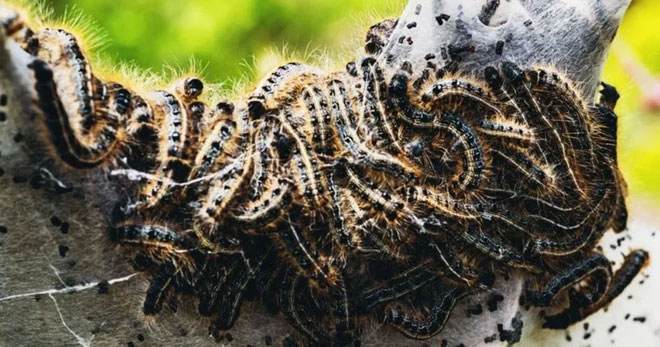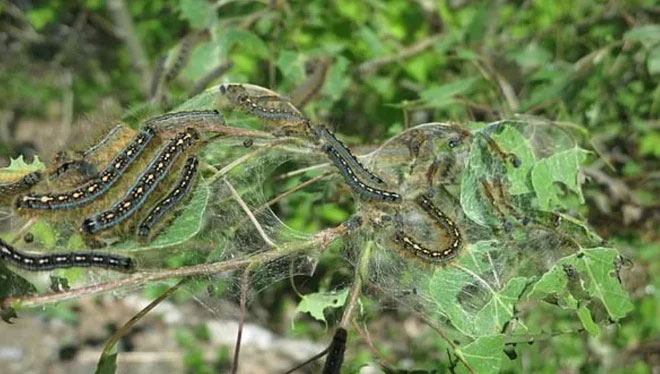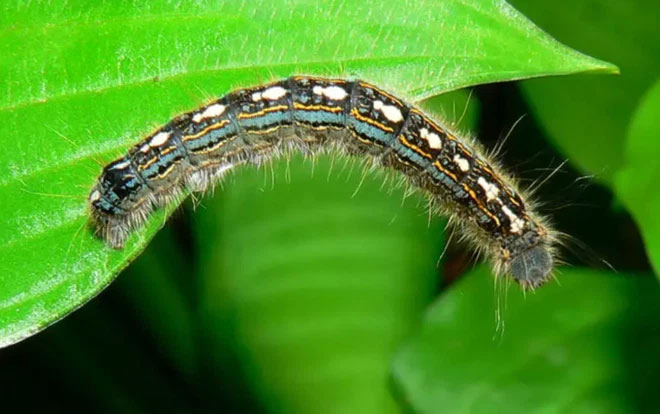Insects, particularly caterpillars, consume so many leaves that a recent study by scientists revealed a significant increase in leaf drop and caterpillar feces, which considerably alters the nutrient cycling—especially carbon and nitrogen—between the soil and nearby lakes.

Insect outbreaks create conditions favorable for the development of greenhouse gas-emitting bacteria.
Insect feces, rich in nitrogen, can wash down to lakes with water, acting like fertilizer for bacteria. These bacteria can then release CO2 into the atmosphere as they break down organic matter. During years of large insect outbreaks, they facilitate the growth of greenhouse gas-emitting bacteria in lakes and suppress algae that help remove CO2 from the atmosphere.
These insects essentially function as tiny machines that convert carbon-rich leaves into nitrogen-rich feces. The feces fall into the lakes instead of leaves, significantly altering the chemical composition of the water and further increasing greenhouse gas emissions from ponds and lakes.
As the climate in temperate regions of the world changes, insect populations are expected to increase and move northward. This raises the risk of leaf drop outbreaks in northern forests, leading to higher CO2 emissions from nearby lakes.
Climate change will create favorable conditions for the growth of broadleaf deciduous trees around lakes, further amplifying the impact of insects.
There is Still Good News
While the impact of insect-induced leaf drop is increasing in both frequency and severity, lakes across the Canadian Shield are also undergoing a process called browning due to the accumulation of dissolved organic carbon, resembling tea, in the water.
The decline in transparency of many lakes is attributed to various factors, including climate change and recovery from historical acid rain events and logging activities.
A 32-year-long monitoring study by scientists shows that outbreaks of leaf-eating caterpillars can effectively offset the carbon accumulation in lakes over the year and significantly improve water transparency.
In years without outbreaks of leaf-eating insects, carbon and nitrogen entering the lakes usually come from decaying leaves and conifer needles. These inputs typically peak in the fall.

Caterpillars have somewhat supplemented the carbon levels in lakes.
During outbreak years, the research team observed that nearby freshwater lakes, particularly those surrounded by deciduous forests, had less than one-third of the dissolved carbon levels because the voracious caterpillars had added to the carbon levels in the lakes.
The long-term benefits of these insect species become increasingly evident as invasive insects attack tree species with fewer leaves, such as stunted aspen forests surrounding large metal smelting operations in Sudbury, Ontario. This 80,000-hectare industrial area is undergoing natural recovery from acid and metal particles that once reached 98%. Previously, this area was known as the largest sulfur pollution site in the world during the 1970s.
The legacy of land loss, pollution, and degradation in Sudbury clearly puts trees at a disadvantage in their battle against leaf-drop-causing insects.
Caterpillars as Small Plows Helping to Rehabilitate Degraded Soil
Trees cannot escape from insects, but they can survive heavy attacks. However, trees around the industrial area in Sudbury struggle to thrive due to other factors.
These factors include moisture loss, low organic matter content in the soil, and decades of accumulated toxic metal particles emitted from smelters.
As a result, these trees become a tasty food source for caterpillars and other insects.

Insects make trees around industrial areas struggle to survive.
In previous laboratory experiments, researchers showed that when L. dispar caterpillars were fed leaves from white birch trees near the factory, they consumed more leaves and produced more fibers, thereby promoting plant growth.
The insect species are making trees around industrial areas struggle to survive. However, improving soil quality is the core issue.
A healthy soil is the largest and safest place to sequester carbon from the atmosphere and is key in our fight against climate change. Farmers certainly understand that protecting and restoring soil quality is essential for sustainable agriculture.
This is why farmers often strive to farm wisely and continuously seek ways to enhance the nutrient content of their soils.
Scientists’ research shows that “greedy” caterpillars play significant roles in altering key characteristics of the global carbon cycle and act as small plows that help improve degraded soil.
The surprising discovery regarding the impact of caterpillars on climate change is the work of three scientists from Laurentian University and the University of Cambridge.


















































